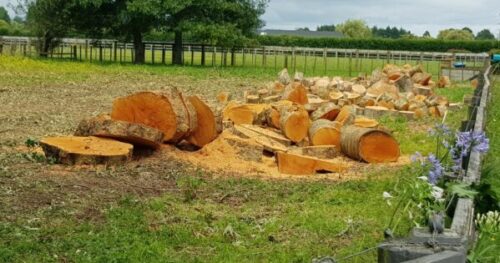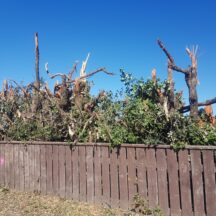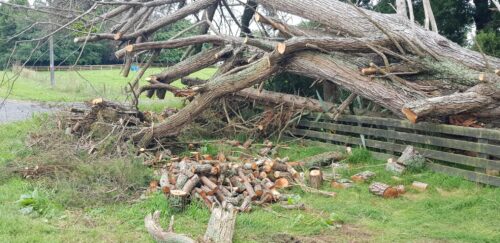Top vs Rear Handle Chainsaws
Top handle or rear handle chainsaw?
That is one of the decisions you will need to make when you decide to buy a new chainsaw.
This can be particularly confusing if you are not sure what the difference between the two design types is and/or how that might impact how you use your new chainsaw.
So which design of chainsaw will better suit your needs?
Apart from that, you will also need to consider whether you want to go the electrically powered chainsaw route or the gas powered route.
There are Pros and Cons in that choice as well, but that is another discussion altogether.
Let’s start by looking at the difference between the two designs
Saw Design and Grip
 Top handled chainsaws are a more recent design and have the handle situated above the motor, This design can be clearly seen in the picture on the left of the Makita top handled battery powered chainsaw featuring a 16 inch bar.
Top handled chainsaws are a more recent design and have the handle situated above the motor, This design can be clearly seen in the picture on the left of the Makita top handled battery powered chainsaw featuring a 16 inch bar.
Whether they are electrically powered or gas powered, these top handle design chainsaws hardly ever have a bar longer than 16 inches but can go as short as 10 inches. Shorter than that and you are looking at mini chainsaws which have yet another design and use!
The more traditional or conventional chainsaw design is the rear handle chainsaw where the handle is positioned behind the engine.
The Weight Issue
While many articles will tell you that top handle chainsaws are lighter than their rear handle counterparts, this observation should not be accepted at face value. There are 2 main reasons for this:
– You need to compare like for like and that is not always that easy.
In other words, you need to compare for example a Makita 14-inch bar battery driven top handled chainsaw (pictured further up) with a Makita 14-inch bar battery driven rear handled chainsaw.
– And when you manage to do that (for any brand of chainsaw), the actual difference in weight is more than likely so small that it will probably not be a major factor in your decision making.
However, in general, there are bigger rear handled chainsaws available in the market. It would be difficult to find a top handled chainsaw with a bar longer than 16 inches while rear handled chainsaws commonly have bars of 20 inches and more.
From that point of view, most rear handled chainsaws are generally bigger and thus heavier than the majority of top handled saws.
On the flip side, the lightest top handle chainsaw will have an electrical rather than a gas motor. Just another aspect to factor into your deliberations!
Tool Balance
The issue of balance is an interesting one. Despite the fact that top handled chainsaws are sometimes referred to as one-handed chainsaws, both designs are actually meant to be operated with two hands. Just in different situations.
The top handled chainsaw has the main weight of the motor situated below the main handle which allows the user to hold and control the chainsaw with one hand while using the other hand on a second handle to guide the bar. However, it was never intended to be only used with one hand!
The positioning of the motor/top handle also means the weight of the tool is below the hands holding the saw which makes it easier to work with the chainsaw for a longer period of time.
On the other hand, the more traditional rear handled chainsaws have the motor in front of the handle and so the majority of the weight is held in front of the user’s body. That position is obviously more taxing for the user!
Power and Performance

Big chainsaws for big jobs!
As we noted above, the bigger and thus more powerful chainsaws are of the rear handle design.
So when you are considering which chainsaw is best for you, you need to consider what bar size and how much power you require of your chainsaw.
In a nutshell, a top handle chainsaw is more than adequate for pruning and trimming and other tasks of a lighter nature.
If you want to tackle a job like this picture shows,then you will need to consider buying a big, powerful (and heavier) rear handled chainsaw.
Size and Compactness
The more compact top handled chainsaw was originally designed for use by people needing to use chainsaws above ground level and in places with limited space to manoeuvre.
In other words, usually up a tree and in dense foliage! In fact, many of these chainsaws have an inbuilt attachment point for either attaching a rope to for pulling the chainsaw up into the tree or for attaching the chainsaw to an arborist climbing saddle.
However, this smaller size may also limit their use for large cutting projects. Rear handle chainsaws, while larger, provide more versatility for different types and sizes of tasks, but may be more difficult to use in tight, confined areas.
Price
Top handle chainsaws were not designed for the average weekend chainsaw warrior. They are made for use by professional arborists, contractors clearing power lines and so on.
As such they tend to have higher specifications, which can make them more expensive than rear handle chainsaws.
However, prices usually vary depending on the brand, features of the model and above all, bar length and thus size of the chainsaw. The bigger the chainsaw, the bigger the price!
Many rear handle chainsaws are more affordable in general, making them a better option for casual users who do not require a professional-grade chainsaw.
Advantages of Top Handle Chainsaws

Because of the position of the handle, these saws tend to be shorter overall when compared to their rear handled counterparts with the same bar length.
This together with the design’s better weight distribution makes it less physically taxing to use them for long periods, especially when perched in a tree or up a ladder or cutting with your arms stretched out above shoulder height!
The likes of arborists, tree care professionals and contractors that keep e.g. power lines clear of trees, often prefer top-handle chainsaws because of their suitability for off-the-ground use.
This is because the handle placement makes them easier to hold and control, especially when working at height (above shoulder level) or in tight spaces. Being lightweight and compact, top-handle chainsaws get you closer to the cutting area. This translates into more precise cutting while using less physical effort.
Safety and Controls
Like all chainsaws, top-handle chainsaws have a safety focus. They come with features that enhance control and help prevent accidents.
Depending on whether they are battery or gas powered, these include safety buttons, variable speed triggers, hand guards and chain brakes.
The focus on safety is perhaps even more crucial for climbing chainsaw users and arborists who often operate in less-than-ideal conditions!
Better Handling in Tight Spaces
One of the driving forces behind their design was the need for a chainsaw with the ability to handle cutting in tight spaces more efficiently. Their compact design and handle placement allows for greater flexibility and control while cutting branches or pruning trees, especially when your feet on not firmly planted on the ground!.
Disadvantages of Top Handle Chainsaws
Limited Power and Cutting Capacity?
Top-handle chainsaws, while lightweight and highly maneuverable, tend to have limited power and cutting capacity compared to rear handle chainsaws.
This is primarily due to their smaller engine size and shorter bar lengths.
As a result, they may struggle when cutting through thick branches or logs and may not be suitable for heavy-duty tasks that require more power. In addition, they are generally lighter in weight which can result in increased vibration during use. This will contribute to user fatigue over extended periods.
NB: the most powerful top handle chainsaw will likely be gas powered and not electrically driven.
Less Suitable for Ground Use
Another disadvantage of top-handle chainsaws is that they are primarily designed for tree climbing and aerial work, which means that they are generally less suitable for ground use, especially cutting logs on the ground.
This is because their weight distribution and ergonomics are not designed for this type of work. Specifically, the design limits the amount of leverage you have over the saw which increases the chance of kickback.
Better Suited to Experienced Chainsaw Users
While one might take the view that a chainsaw is a chainsaw regardless of design, there are several good reasons why top-handle chainsaws are not recommended for beginners.
For a start, and perhaps somewhat counter intuitively, their light(er) weight and alternative design make them harder to control. For a newbie, this inevitably increases the chance of accidents happening.
Secondly, the increased vibration experienced when using the saw may be difficult for inexperienced users to manage, especially during extended working sessions.
Finally, the potentially increased likelihood of kickback happening can be dangerous for beginners who have not yet developed the necessary skills to react quickly to that specific situations.
Taking all these points into consideration, it would perhaps be better for an inexperienced person to start their chainsaw journey with a rear handle type chainsaw.
Advantages of Rear Handle Chainsaws
More Power and Cutting Capability

As we have already stressed, the apparent increased power and thus chain speed (= cutting ability) has more to do with the type and size of motor and the bar length than the design type of the chainsaw.
But we also know that the rear handle chainsaw design can accommodate bigger and heavier motors and longer bars.
So in general we can say that these chainsaws are more capable when it comes to heavy duty work
Ideal When Felling Trees or Cutting Up Logs
A significant advantage of rear-handle chainsaws is their suitability for felling trees and working on the ground. While climbing chainsaws are designed for off-the-ground tasks, rear handle chainsaws excel when it comes to ground-based tasks such as felling trees or cutting logs.
Beginner Friendly and Ideal For Homeowner Use
Rear handle chainsaws are not just for professionals; they are also beginner-friendly and perfect for homeowners who need to do occasional cutting tasks. The time-tested design, combined with their added leverage and control gives assurance to users who may not have much, or any, experience with chainsaws.
In other words, they offer a simple introduction to those new to chainsaws.
This beginner-friendly nature and suitability for many homeowner tasks make them a popular choice among users who require a reliable chainsaw for a variety of cutting jobs.
Disadvantages of Rear Handle Chainsaws
Less Maneuverable in Tight Spaces
It can be challenging to maneuver rear handle chainsaws in tight spaces due to their length and weight.
When it comes to trimming tasks or cutting in confined areas, rear handle chainsaws may be less comfortable to use than their top-handle counterparts. Their design often makes it difficult for users to work overhead or in tight spaces.
Heavier and Less Suited for Climbing
Rear-handle chainsaws are often heavier and longer than their top-handled cousins. This has several implications for users of these saws including:
- The increased weight can lead to increased user fatigue when working for long periods.
- The additional weight also makes it more difficult for them to be used in climbing activities or tasks that require working at heights or overhead.
- More weight means an increased strain on the user’s body. This may contribute to decreased productivity and overall performance.
Let’s Recap
There are distinct differences between the two designs of chainsaw under consideration here.
Top handled chainsaws have a more compact design and better weight distribution. They are easier to maneuver in tight spaces and are better suited for working above ground as well as overhead.
However, they are somewhat limited in bar size (max 16 inches?) and in terms of safe operation, are perhaps better suited in experienced hands.
By contrast, rear handle chainsaws are not restricted to short bar lengths and are ideal for tree felling and/or cutting up larger logs and branches, including those lying on the ground.
.Ultimately, the answer to your own Top or Rear Handle Chainsaw debate will depend on your specific experience, needs and preferences.

